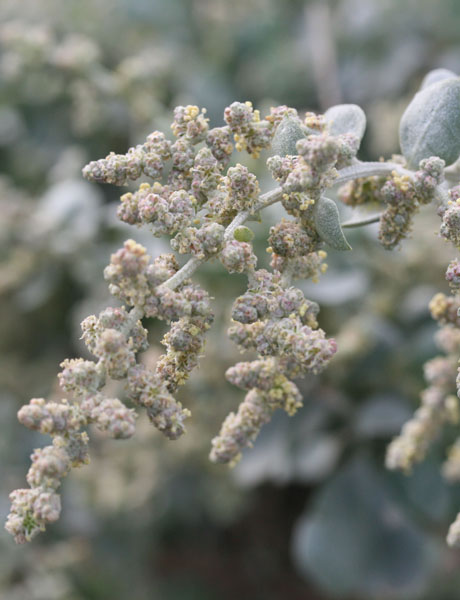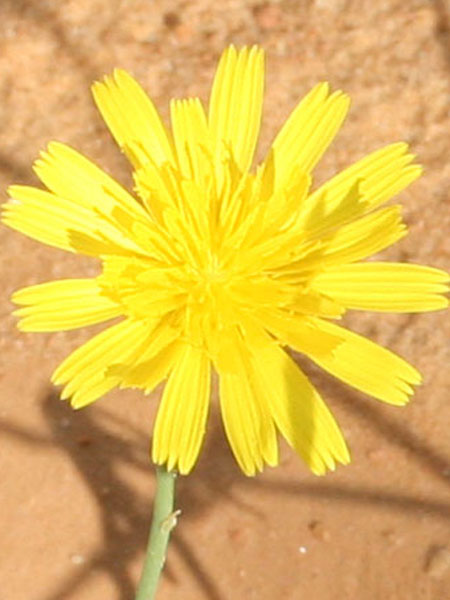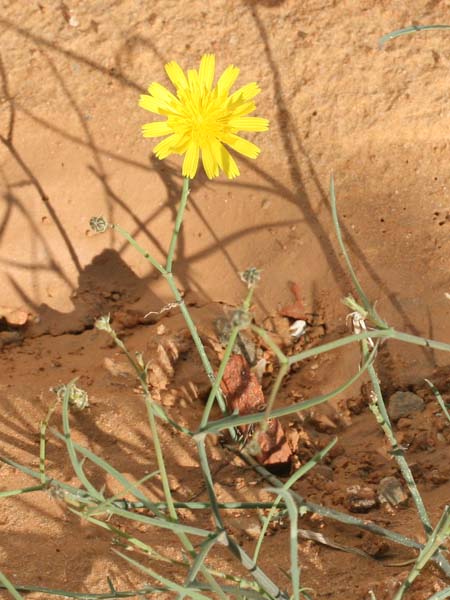Limoniastrum monopetalum
Kingdom : Plantae / النّباتات
Division : Spermaphyta / البذريات
Clade : Magnoliophyta or Angiospermae / مستورات البذور
Class : Eudicotyledoneae / ذات الفلقتين
Order : Caryophyllales / رتبة القرنفليات
Family : Plumbaginaceae /الفصيلة الرّصاصيّة
Genus : Limoniastrum
species : monopetalum
Chromosomes: 2n=72
Protologue
(L.) Boiss. in A. DC., Prodr. 12: 689 (1848)
Synonyms
Statice monopetala L., Sp. Pl., ed. 1, 276 (1753)
Common names
Tunisia Arabic English French Tamazight
الزّيته
زُوِيْتَة
لِيْمونِيُون كاذب
Limoniastrum
Limoniastre
Limoniastrum monopétale
Statice arbustif
Grand statice
Lavande de mer
Tafoufela
Toxic
no
Edible
no
Latex
no
Botanic description
Genus description
"Tubular calyx without rib, terminated by 5 acute lobes. Corolla in funnel, very spread out, with 5 acute lobes. Stamens with thread welded to the tube of the corolla. Styles welded to the middle, threadlike stigmas. Inflorescences composed of 1-pluriflorous spikelets, surrounded at the base of 2-3 scarious bracts. Spikelets in loose spike, with articulated axis. Stems with alternate leaves, whole, fleshy,
Species description
"Subshrub very hairless glabrous from 50 cm to 1.30 m whitish green, sometimes rough to the touch due to saline exudates.
Stems twigs in tuft Leaves persistent, lanceolate-spatulate greenish-green, 2.5 to 8 cm long sometimes rough to the touch due to saline exudates, slightly embracing. Flowers with red chalice with acute lobes, Corolla with 5 purple petals very exerted. Inflorescence Spikelets 1-2 flores, narrowly applied against the axis.
Botanic References
Pottier-Alapetite G. (1981). Flore de la Tunisie Angiospermes –Dicotylédones (Gamopétales première partie). Imprimerie Officielle de la République Tunisienne (Eds), 694 p. Edouard LE FLOC’H, Loutfy BOULOS et Errol VELA. (2010). Catalogue synonymique commenté de la FLORE DE TUNISIE. République Tunisienne, Ministère de l’Environnement et du développement durable, Banque Nationale de Gènes. 500 p www.theplantlist.org
Biology
Life form Perennial Type form Nanophanerophyte Photosynthesis C3
Phenology
Blooming
JanuaryFebruaryMarchAprilMayJuneJulyAugustSeptemberOctoberNovemberDecember
Fruiting
JanuaryFebruaryMarchAprilMayJuneJulyAugustSeptemberOctoberNovemberDecember
Map Localization
Ecology
Adaptation It is most widespread in semi-arid to arid bioclimates and it disappears in the southern and extreme south. Salt bladder yes Invasive no
Geographical distribution
Localization Biocimatic stage Annuel pluviometry (mm) GPS Monastir (Skanès, Déc.2013, Oct . 2014, Juillet 2016) Inferior semi-arid 331 35°46'43.48"N / 10°47'37.58"E Monastir (Sidi Ghedemssi, Déc.2014, Fév.2016, Juillet 2016) Inferior semi-arid 331 35°47'8.42"N / 10°49'59.96"E
General uses
Its galls are used in southern Tunisia for tanning leathers and dyeing hair.
Medicinal uses
"The herbal tea of galls and leaves is used in traditional medicine as anti-dysenteric against infectious or parasitic diseases that cause painful and bloody diarrhea.
NOTE : This website is not that of herbal medicine and assumes no responsibility for the negative effects of the use of plants. Seek advice from a professional before using a medicinal plant.
Systems / Organs / Effects
Digestive System Scalp
Dispersion mode
Germination
Duration
Image
Description of the seeds
Form External structure Ornamentation Type of seed Average length of 10 seeds ± (mm) Average width of 10 seeds ± (mm) Average thickness of 10 seeds ± (mm) Average mass of 100 seeds (g)
Test results
TPC DPPH ABTS+ FRAP Year mg GAE g-1 MS CI50 g ml-1 CI50 g ml-1 CE50 g ml-1 41,88± 2,49 34,99± 0,64 37,84± 0,21 98,10± 2,87 2016 Total Phenols content(TPC), Anti-radical potentialities against (DPPH, ABTS), Ferric reducing antioxidant power(FRAP)
Molecules : ADN / Proteins
Chromosomes : 72 Uniprot NCBI
Tunisian references
Chaieb M and Boukhris M. (1998). Flore succinte et illustrée des zones arides et sahariennes de Tunisie. Association pour la protection de la nature et de l’environnement, Sfax.204 p. Trabelsi N, Megdiche W, Ksouri R, Falleh H, Oueslati S, Soumaya B, Hajlaoui H, Abdelly C. (2010). Solvent effects on phenolic contents and biological activities of the halophyte Limoniastrum monopetalum leaves. LWT-Food Sci Technol. 43:632–639101. Trabelsi N, Falleh H, Jallali I, Ben Daly A, Hajlaoui H, Smaoui A, Abdelly C, Ksouri R.(2012).Variation of phenolic composition and biological activities in Limoniastrum monopetalum L. organs. Acta Physiol Plant. 34:87–96






































